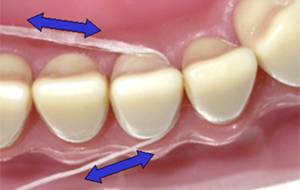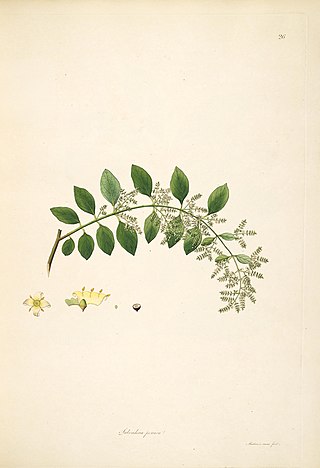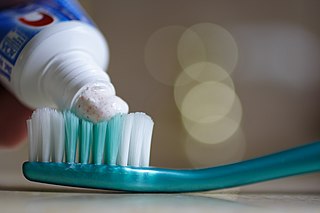

A teeth-cleaning twig (in India: datun [1] ) is an oral hygiene tool made from a twig from a tree. It can help to prevent tooth decay and gum disease.


A teeth-cleaning twig (in India: datun [1] ) is an oral hygiene tool made from a twig from a tree. It can help to prevent tooth decay and gum disease.
Chew sticks are twigs or roots of certain plants that are chewed until one end is frayed. This end can be used to brush against the teeth, [2] while the other end can be used as a toothpick. [3] The earliest chew sticks have been dated to Babylonia in 3500 BCE [3] and an Egyptian tomb from 3000 BCE; [2] they are mentioned in Chinese records dating from 1600 BCE [3] In the Ayurvedas around 4th century BCE and in Tipitaka, in the Buddhist Canon around the 5th century BCE in India. [4] [5]
The Indian way of using tooth wood for brushing is presented by the Chinese Monk Yijing (635–713 CE) when he describes the rules for Monks in his book: [6]
Every day in the morning, a monk must chew a piece of tooth wood to brush his teeth and scrape his tongue, and this must be done in the proper way. Only after one has washed one’s hands and mouth may one make salutations. Otherwise both the saluter and the saluted are at fault. In Sanskrit, the tooth wood is known as the dantakastha—danta meaning tooth, and kastha, a piece of wood. It is twelve finger-widths in length. The shortest is not less than eight finger-widths long, resembling the little finger in size. Chew one end of the wood well for a long while and then brush the teeth with it.
A wide variety of plants can be used as dantakastha. [7]
In Africa, chew sticks are made from the tree Salvadora persica , also known as the "toothbrush tree". In Islam, this tree is traditionally used to create a chew stick called miswak, as frequently advocated for in the hadith (written traditions relating to the life of Muhammad). [8]
In South India, neem is used as a teeth cleaning twig. Neem, in full bloom, can aid in healing by keeping the area clean and disinfected.
Traditional Sikhs still use datun today as it is written in their scriptures:
ਦਾਤਨ ਕਰੇ ਨਿਤ ਨੀਤ ਨਾ ਦੁਖ ਪਾਵੈ ਲਾਲ ਜੀ ॥ (੨੩)
("Dear/beloved, natural twig, brush everyday, and pains you shall never get." (23))


Teeth-cleaning twigs can be obtained from a variety of tree species. Although many trees are used in the production of teeth-cleaning twigs, some trees are better suited to clean and protect the teeth, due to the chemical composition of the plant parts. The tree species are: [10] [11] [12] [13] [14] [15]
Europe and North America
Australia
India
Many companies produce special cases for carrying, storing and protecting chew sticks, known popularly as "miswak holders".
When compared to toothbrushes, teeth-cleaning twigs have several peculiarities:[ unbalanced opinion? ]

Azadirachta indica, commonly known as neem, margosa, nimtree or Indian lilac, is a tree in the mahogany family Meliaceae. It is one of two species in the genus Azadirachta. It is native to the Indian subcontinent and to parts of Southeast Asia, but is naturalized and grown around the world in tropical and subtropical areas. Its fruits and seeds are the source of neem oil. Nim is a Hindustani noun derived from Sanskrit nimba (निंब).

A toothbrush is an oral hygiene tool used to clean the teeth, gums, and tongue. It consists of a head of tightly clustered bristles, atop of which toothpaste can be applied, mounted on a handle which facilitates the cleaning of hard-to-reach areas of the mouth. They should be used in conjunction with something to clean between the teeth where the bristles of the toothbrush cannot reach - for example floss, tape or interdental brushes.
Teeth cleaning is part of oral hygiene and involves the removal of dental plaque from teeth with the intention of preventing cavities, gingivitis, and periodontal disease. People routinely clean their own teeth by brushing and interdental cleaning, and dental hygienists can remove hardened deposits (tartar) not removed by routine cleaning. Those with dentures and natural teeth may supplement their cleaning with a denture cleaner.

Dental floss is a cord of thin filaments used in interdental cleaning to remove food and dental plaque from between teeth or places a toothbrush has difficulty reaching or is unable to reach. Its regular use as part of oral cleaning is intended to maintain oral health.

A toothpick is a small thin stick of wood, plastic, bamboo, metal, bone or other substance with at least one and sometimes two pointed ends to insert between teeth to remove detritus, usually after a meal. Toothpicks are also used for festive occasions to hold or spear small appetizers or as a cocktail stick, and can be decorated with plastic frills or small paper umbrellas or flags.

Salvadora persica or the toothbrush tree is a small evergreen tree native to the Middle East, Africa and India. Its sticks are traditionally used as a natural toothbrush called miswak and are mentioned by the World Health Organization for oral hygiene use.

Dentifrices, including toothpowder and toothpaste, are agents used along with a toothbrush to aid in removal of dental plaque. They are supplied in paste, powder or gel. Many dentifrices have been produced over the years, some focusing on marketing strategies to sell products, such as offering whitening capabilities. The most essential dentifrice recommended by dentists is toothpaste which is used in conjunction with a toothbrush to help remove food debris and dental plaque. Dentifrice is also the French word for toothpaste.

The miswak is a teeth-cleaning twig made from the Salvadora persica tree. The miswak's properties have been described thus: "Apart from their antibacterial activity which may help control the formation and activity of dental plaque, they can be used effectively as a natural toothbrush for teeth cleaning. Such sticks are effective, inexpensive, common, available, and contain many medical properties".

Streblus asper is a tree known by several common names, including Siamese rough bush, khoi, serut, and toothbrush tree. It is a medium-sized tree native to dry regions in Indonesia, Cambodia, Thailand, India, Sri Lanka, Malaysia, and Vietnam.

Vachellia nilotica, more commonly known as Acacia nilotica, and by the vernacular names of gum arabic tree, babul, thorn mimosa, Egyptian acacia or thorny acacia, is a flowering tree in the family Fabaceae. It is native to Africa, the Middle East and the Indian subcontinent. It is also considered a 'weed of national significance' and an invasive species of concern in Australia, as well as a noxious weed by the federal government of the United States.

Tooth brushing is the act of scrubbing teeth with a toothbrush equipped with toothpaste. Interdental cleaning can be useful with tooth brushing, and together these two activities are the primary means of cleaning teeth, one of the main aspects of oral hygiene. The recommended amount of time for tooth brushing is two minutes.

Dalbergia sissoo, known commonly as North Indian rosewood or shisham, is a fast-growing, hardy, deciduous rosewood tree native to the Indian subcontinent and southern Iran. D. sissoo is a large, crooked tree with long, leathery leaves and whitish or pink flowers.

Oral hygiene is the practice of keeping one's oral cavity clean and free of disease and other problems by regular brushing of the teeth and adopting good hygiene habits. It is important that oral hygiene be carried out on a regular basis to enable prevention of dental disease and bad breath. The most common types of dental disease are tooth decay and gum diseases, including gingivitis, and periodontitis.

A tongue cleaner is an oral hygiene device designed to clean the coating on the upper surface of the tongue. While there is tentative benefit from the use of a tongue cleaner it is insufficient to draw clear conclusions regarding bad breath.
Sarakan is the brand name for a range of oral health products owned by G.R Lane Health Products Ltd.

Meswak is a fluoride-free toothpaste brand that was launched in India by Balsara Hygiene in 1998. The toothpaste is marketed as a herbal toothpaste as it is made from extracts of the Salvadora persica plant. The teeth cleaning twig of the plant is reputed to have been used over 7,000 years ago.
Cassia sieberiana, the drumstick tree, is a tree in the family Fabaceae native to Africa. It ranges from 10 to 20 metres in height and has very bright yellow flowers. It is used for multiple medical purposes in Africa and is found in the secondary jungle of a forest.
Interdental cleaning or interproximal cleaning is part of oral hygiene where the aim is to clean the areas in between the teeth, otherwise known as the proximal surfaces of teeth. This is to remove the dental plaque in areas a toothbrush cannot reach. The ultimate goal of interproximal cleaning is to prevent the development of interproximal caries and periodontal disease. The combined use of tooth brushing, and mechanical and manual interdental cleaning devices has been proven to reduce the prevalence of caries and periodontal diseases.

The Army Dental Corps (ADC) is a specialist corps in the Indian Army which primarily provides dental services to all Army personnel, serving and veterans, along with their families.
[ Bhojpuri ]datwan, dantwan, [ Hindi ]datwoon 'toothbrush; twig for cleansing the teeth'
{{cite journal}}: Cite journal requires |journal= (help)CS1 maint: DOI inactive as of January 2024 (link)